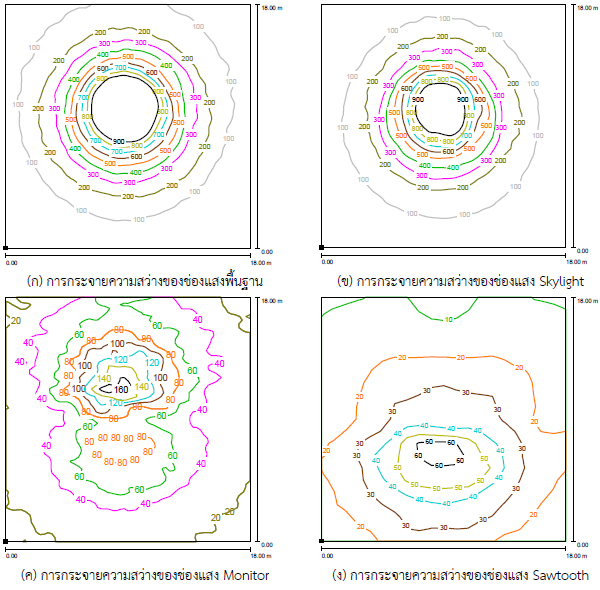Toplighting techniques for buildings in Thailand
Main Article Content
Abstract
This work investigated how toplighting techniques perform in buildings in Thailand. Four toplighting techniques are included in the study, which comprises: (1) base-case skylight; (2) skylight; (3) monitor; and (4) sawtooth. A single story building with 8 m. height ceiling was taken as a studied building. Firstly, room sections showing each toplighting techniques were analyzed to illustrate sunlight directions and sky dome areas seen by the openings. Then a simulation program, DIALux 4.13 was used to compute illuminance for each technique. The computed illuminance values were obtained on the floor and on the 3 m. plane below the ceiling. The simulation times were 9:00, 12:00 and 15:00 hrs. under partly cloudy sky on the 21st of March, June, September and December. The second part of this work investigated toplighting guidelines for calculating daylight factor by comparing computed daylight factor values with calculated daylight factor. The results suggest that the calculated daylight factors are comparable in particular values calculated by monitor and sawtooth techniques. Daylight distributions from all toplighting included in this study show that highest daylight levels are approximately below the ceiling openings. Daylight distribution patterns could be assessed by section analysis.
Article Details

This work is licensed under a Creative Commons Attribution-NonCommercial-NoDerivatives 4.0 International License.
References
Egan, M. D., & Olgyay, V. (2002). Architectural Lighting. (2nd ed.). Boston: McGraw Hill.
Chirarattananon, S., & Limmechokchai, B. (1996). Daylight potential in Thailand. Energy Sources, 18, 875-883.
ยิ่งสวัสดิ์ ไชยะกุล. (2549, 27-29 กรกฎาคม 2549 ). กฎอย่างง่ายและแบบจำลองคณิตศาสตร์เพื่อหาระดับความส่องสว่างจากหน้าต่าง. การประชุมวิชาการเครือข่ายพลังงานแห่งประเทศไทยครั้งที่ 2, มหาวิทยาลัยเทคโนโลยีสุรนารี จังหวัดนครราชสีมา.
ศิวดล อุปพงษ์, & ยิ่งสวัสดิ์ ไชยะกุล. (2556). การใช้แสงธรรมชาติในอาคารผ่านท่อนำแสงแนวดิ่ง. วารสารวิชาการคณะสถาปัตยกรรมศาสตร์ มหาวิทยาลัยขอนแก่น, ปีที่ 12, 78-85.
วัชรินทร์ วิมานจตุรงค์, & ธาริณี รามสูต. (2559). การใช้แสงธรรมชาติในห้างค้าปลีกขนาดใหญ่ผ่านท่อนำแสงแนวดิ่ง. การประชุมวิชาการเทคโนโลยีอาคารด้านพลังงานและสิ่งแวดล้อม ครั้งที่ 3, โรงแรม เซ็นทารา คอนเวนชั่นเซ็นเตอร์ ขอนแก่น.
Chaiyakul, Y. (2013). Daylighting in building through a vertical light pipe in Thailand. TSkylight basecase he Lux Pacifica 2013, Bangkok.
Chirarattananon, S., Chedsiri, S., & Renshen, K. (2000). Daylighting through light pipes in the tropics. Solar Energy, 69(4), 331-341.
Lechner, N. (1991). Heating, Cooling, Lighting Design Methods for Architects. New York: John Wiley & Sons.
Stein, B., & Reynolds, J. S. (2000). Mechanical and Electrical Equipment for Buildings. (9th ed.). New York: John Wiley & Sons.
DIALux. (2018). DIALux (Version Version 4.13): DIALux. Retrieved from http://www.dial.de
พงศักดิ์ จงหมายกลาง, & ยิ่งสวัสดิ์ ไชยะกุล. (2558). การให้แสงสว่างในอาคารโฮมสโตร์ในปัจจุบัน. วารสารวิชาการ โฮมภูมิ ปีที่ 2 ฉบับที่ 2, 193-212.
TIEA. (2003). TIEA-GD003(WD): TIEA Guide of Recommended Interior Illumination level. Bangkok: TIEA.


